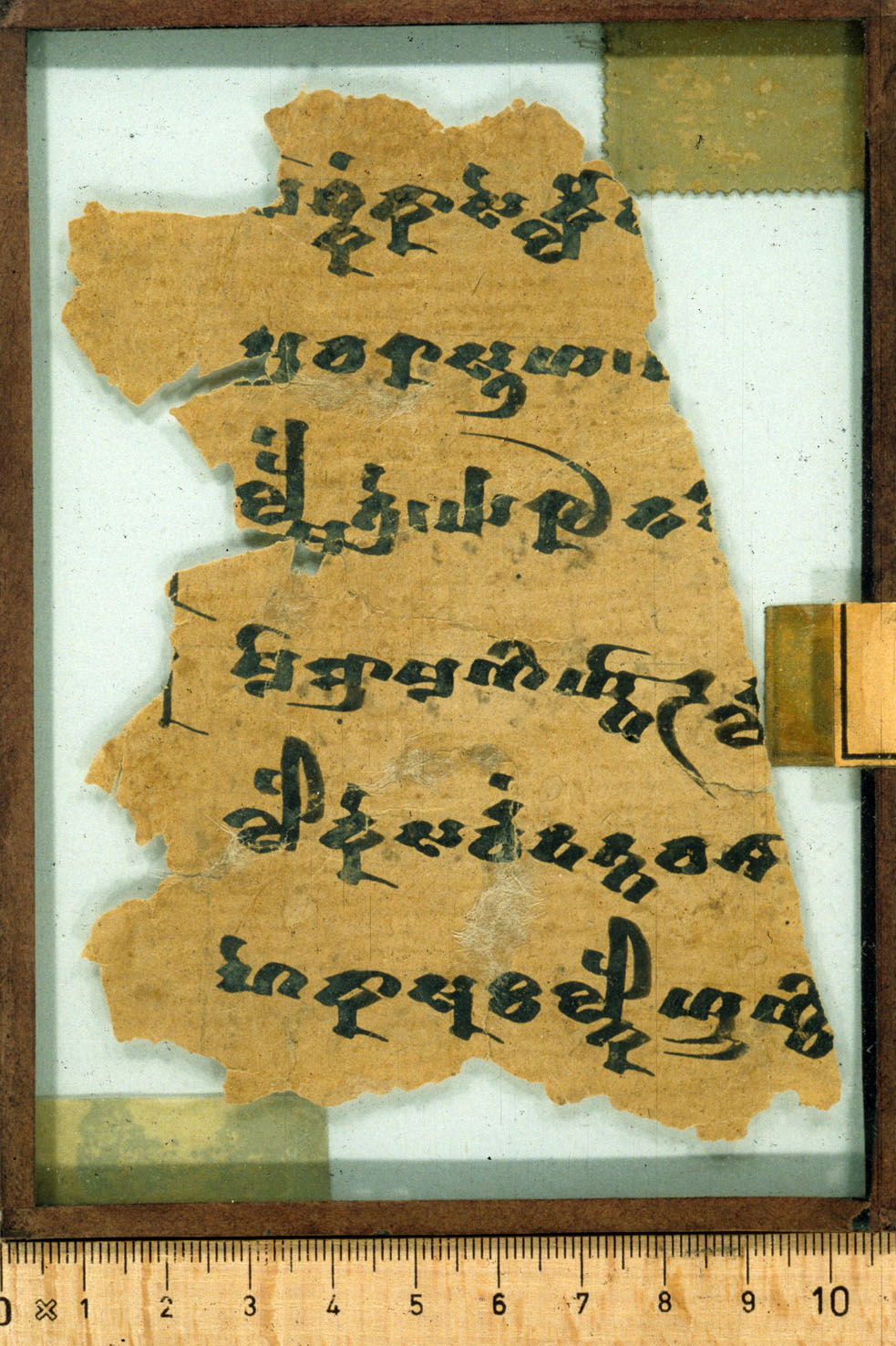A 392
| Known as: | A 392; THT 1026 |
|---|---|
| Cite this page as: | Gerd Carling (text); Michaël Peyrot (commentary). "A 392". In A Comprehensive Edition of Tocharian Manuscripts (CEToM). Created and maintained by Melanie Malzahn, Martin Braun, Hannes A. Fellner, and Bernhard Koller. https://cetom.univie.ac.at/?m-a392 (accessed 12 Jul. 2025). |
Edition | |
| Editor: | Gerd Carling (text); Michaël Peyrot (commentary) |
Provenience | |
| Main find spot: | Bezeklik |
| Expedition code: | T III M 135.3 |
| Collection: | Berlin Turfan Collection |
Language and Script | |
| Language: | Skt.; TA |
| Script: | classical |
Text contents | |
| Title of the work: | Varṇārhavarṇastotra |
| Passage: | 7.11-17 |
| Text genre: | Literary |
| Text subgenre: | Buddhastotra |
| Verse/Prose: | prose |
Object | |
| Manuscript: | A 391-392 |
| Material: | ink on paper |
| Form: | Poṭhī |
| Number of lines: | 7 |
Images
Images from idp.bl.uk by courtesy of the International Dunhuang Project, the Berlin-Brandenburgische Akademie der Wissenschaften, and the Staatsbibliothek zu Berlin – Orientabteilung.
Transliteration
| a1 | gra sto : brā hma ṇa kiṃ bha [v]i /// |
|---|---|
| a2 | śkaṃ to¯ ¯m kle śā¯ ¯ñä tñi ā /// |
| a3 | sā pha lya mā ga ta ḥ [10] /// |
| a4 | o ko lyo cka¯ ¯s̝t ta [m](·)o /// |
| a5 | o kta si ytā rne rvāṃ /// |
| a6 | dṛ śa ka ści dbha va /// |
| lf | [60] [7] |
| b1 | [mā] śkaṃ kā se klo /// |
| b2 | pra va rā stra ya ḥ [10] /// |
| b3 | lmeṃ tre : 10 5 na ·[i] /// |
| b4 | mā brā ma ṇi ytā¯ ¯r kl· /// |
| b5 | lo ke sa rvaṃ ta tta va śā /// |
| b6 | he kā su ka lko yru ñci /// |
Transcription
| lf | 60-7 |
| * | (kudṛṣṭivimati)¬ |
|---|---|
| a1 | graston1 : brāhmaṇa kiṃ bhavi(ṣyati) /// |
| a2 | n2 śkaṃ tom kleśāñ tñi ā(kṣiñluneyäṣ) /// |
| a3 | n3 sāphalyam āgataḥ 10(-2) /// |
| a4 | n4 oko lyockäṣt täm(y)o /// |
| a5 | n5 oktasi ytār nervāṃ /// (sa)¬ |
| a6 | dṛśan6 kaś cid bhava(ti) /// |
| b1 | n7n8 mā śkaṃ kāse klo /// (brāhmaṇa)¬ |
| b2 | pravarāsn9 trayaḥ 10(-5) /// (śpā)¬ |
| b3 | lmeṃn10n11 tre : 10-5 na (h)i /// |
| b4 | n12 mā brāmaṇi ytār kl(awanträ) /// |
| b5 | n13 loke sarvaṃ tat tava śā(sanāt) /// (e)¬ |
| b6 | hen14 kāsu kälko yruñci /// |
Commentary
Remarks
| Transcription and references have been transferred from the "Text and Reference Database of the Tocharian A Language" (Gerd Carling Lund University) (funded by the Bank of Sweden Tercentenary Foundation and SCAS). | |
| Transcription and translation are based on Carling et al. 2009. | |
| The reading of the leaf number is very uncertain. The first akṣara (there was probably no other one on top of this one) seems to be ‹60›, the second may be ‹7›, ‹8›, or ‹9›. If the reading of at least the ‹60› is correct, the manuscript will have contained another text preceding the Varṇārhavarṇastotra: with approximately 7 strophes per leaf, the beginning of the latter text may have to be placed about 35 leaves before this one. |
Linguistic commentary
| Striking is s for ts in a5 oktasi and b1 kāse. |
Parallel texts
| Hartmann 1987: 223-227 |
Philological commentary
| In this text, the Tocharian A translations seem to follow after each complete Sanskrit strophe (instead of each half pāda, as is often the case). | |
| n1 | 7.11a-b |
| n2 | śkaṃ tom kleśāñ tñi: parts of the translation of 7.11c-d na ceme granthayo 'nyatra cchidyante tvanmatād ṛte 'Diese Fesseln werden aber nirgends als in deiner Lehre zerschnitten.' (Hartmann 1987: 223). The syntax of the Tocharian A translation is different. Couvreur 1966: 176 plausibly suggests to restore ā /// to ā(kṣiñluneyäṣ pkänt), which would give us something like '(Apart from) your teaching, these kleśas are (not cut off)'. |
| n3 | cf. 7.12d tvayi sāphalyam āgataḥ. |
| n4 | oko lyockäṣt: renders 7.12d tvayi sāphalyam āgataḥ (see line a3; pace Peyrot 2013b: 745) 'hat in dir ihre Erfüllung gefunden' (Hartmann 1987: 224). However, literally the Tocharian A seems to mean 'you have turned [it] into fruit' (taking a little more freedom, Couvreur 1966: 176 translates 'liet de vrucht ontstaan', i.e. '[you] let the fruit arise'). täm(y)o 'therefore' seems to begin a next clause that has no precise Sanskrit parallel. |
| n5 | oktasi ytār nervāṃ 'the eightfold path, the nirvāṇa' may perhaps somehow, but certainly not literally, correspond to 7.13a pratipad brāhmī 'den Brahma zugehörigen Weg' (Hartmann 1987: 224). The literal correspondence of pratipad brāhmī is found in line b4. |
| n6 | cf. 7.14a-b na tvayā saṃskṛtaḥ kaś cid bhavati brāhmaṇo 'śuciḥ 'Nicht wird irgendein durch dich (rituell) gereinigter Brahmane (wieder rituell) unrein' (Hartmann 1987: 225). The variant reading (sa)dṛśa{ḥ} attested here is certain. |
| n7 | [mā]: can be read pace Sieg and Siegling 1921: 217. |
| n8 | mā śkaṃ kāse klo: translates 7.14c na copanīto 'und nicht fällt ein (von dir) eingeführter' (Hartmann 1987: 225). kāse klo (for kātse klo) literally means 'led close' and is without doubt a calque (Skt. upa = TA kātse, Skt. nī- = TA kälā-. |
| n9 | 7.15d. |
| n10 | (śpā)lmeṃ tre: last part of the translation 7.15d brāhmaṇapravarās trayaḥ 'die drei brahmanischen Ahnherren' (Hartmann 1987: 225). |
| n11 | na (h)i: beginning of Skt. 7.16a. |
| n12 | mā brāmaṇi ytār kl(awanträ): renders 7.16b na brāhmī pratipat kva cit 'nirgendwo den brahmanischen Weg' (Hartmann 1987: 226). Couvreur 1966: 177 restores to kl(yant naṣ) 'bevindt zich [niet]', i.e. 'is [not] there', but the relevant akṣara can only be kla or klā. With the restoration kl(awanträ), a literal translation of the Tocharian A text becomes: 'they do [not] call the Brahmanic path'. |
| n13 | The end of 7.17.a, and 7.17b. |
| n14 | (e)he kāsu kälko yruñci: renders the beginning of 7.17c (sugatāve)ṇikaivaiṣā 'gerade nur [dem Wohlgegangenen] eigentümlich ist' (Hartmann 1987: 227. There is no place for the equivalent of TA ehe 'oh' in the restored Skt. text. On yruñci, the equivalent of Skt. āveṇika 'independent; characteristic', see Couvreur 1966: 177. |
References
Online access
IDP: THT 1026; TITUS: THT 1026
Edition
Sieg and Siegling 1921: 217; Couvreur 1966: 176-177; Sieg and Siegling 1921 p. 217
Translations
Knoll 1996: a5 (128), b6 (141)
Bibliography
Carling, Gerd, Georges-Jean Pinault, and Werner Winter. 2009. A dictionary and thesaurus of Tocharian A. Volume 1: Letters a-j. Wiesbaden: Harrassowitz.
Couvreur, Walter. 1966. “Sanskrit-Tochaarse Mātṛceṭafragmenten.” Orientalia Gandensia 3: 159–185 + I.
Hartmann, Jens-Uwe. 1987. Das Varṇārhavarṇa des Mātṛceṭa. Sanskrittexte aus den Turfanfunden, XII. Göttingen: Vandenhoeck & Ruprecht.
“The International Dunhuang Project: The Silk Road Online.” n.d. http://idp.bl.uk.
Knoll, Gabriele. 1996. “Die Verwendungsweisen der Adjektive im Tocharischen.” PhD, Universität Frankfurt am Main.
Peyrot, Michaël. 2013b. The Tocharian subjunctive. A study in syntax and verbal stem formation. Vol. 8. Brill’s Studies in Indo-European Languages & Linguistics. Leiden/Boston: Brill.
Sieg, Emil, and Wilhelm Siegling. 1921. Tocharische Sprachreste, I. Band. Die Texte. A. Transcription. Berlin/Leipzig: de Gruyter.
Sieg, Emil, and Wilhelm Siegling. 1921. Tocharische Sprachreste, I. Band. Die Texte. A. Transcription. Personal annotated copy of Wilhelm Siegling. Scanned by Douglas Q. Adams with the technical assistance of Michael Tarabulski and Kevin Dobbins. Berlin/Leipzig: de Gruyter.
Gippert, Jost, Katharina Kupfer, Christiane Schaefer, and Tatsushi Tamai. n.d. “Thesaurus Indogermanischer Text- und Sprachmaterialien (TITUS): Tocharian Manuscripts from the Berlin Turfan Collection.” http://titus.fkidg1.uni-frankfurt.de/texte/tocharic/thtframe.htm.




